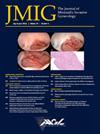Inguinal Canal Endometriosis
IF 3.5
2区 医学
Q1 OBSTETRICS & GYNECOLOGY
引用次数: 0
Abstract
Study Objective
Demonstrate a successful laparoscopic removal of endometriosis from within the inguinal canal, underscore the importance of pre-operative MRI imaging, and provide education on anatomy and surgical technique.
Design
Step-by-step video explanation of a single patient undergoing a laparoscopic removal of endometriosis from the inguinal canal.
Setting
Operating room.
Patients or Participants
A single patient with MRI imaging revealing endometriosis invasion into the inguinal canal and local vasculature.
Interventions
The patient's abdomen was entered and vasculature was identified to prevent major bleeding. Appropriate exposure was achieved by transecting the round ligament to provide a landmark for the inguinal canal. The endometriosis was identified and dissected off the external iliac vasculature and the abdominal wall using the squeeze technique. The endometriosis was then dissected out of the inguinal canal, off the femoral artery, and then removed from the abdomen.
Post-operatively, the patient was started on norethindrone acetate to suppress any residual disease and prevent recurrence.
Measurements and Main Results
The patient noted immediate pain relief in the recovery room. One year post-operatively, patient continued to endorse pain relief and no signs of hernia.
Conclusion
Endometriosis within the inguinal canal is of rare occurrence. It typically presents as a groin lump or pain that is worse with menstruation. As the endometriosis is in close proximity to the abdominal wall and local vasculature, MRI imaging, as well as general surgery and vascular surgery consultation, are necessary for proper surgical planning. These are difficult operations that require proper understanding of pelvic and inguinal canal anatomy.
腹股沟子宫内膜异位症
研究目的展示腹腔镜下从腹股沟管内成功切除子宫内膜异位症的手术,强调术前磁共振成像的重要性,并提供解剖学和手术技巧方面的教育.设计视频逐步讲解一名患者腹腔镜下从腹股沟管内切除子宫内膜异位症的手术过程.患者或参与者一名核磁共振成像显示子宫内膜异位症侵入腹股沟管和局部血管的单个患者。干预措施进入患者腹部并识别血管以防止大出血。通过横断圆韧带为腹股沟管提供标志,从而获得适当的暴露。确定子宫内膜异位症后,使用挤压技术从髂外血管和腹壁上剥离子宫内膜异位症。然后将子宫内膜异位症从腹股沟管、股动脉上剥离,再从腹部切除。术后,患者开始服用醋酸炔诺酮,以抑制任何残留疾病,防止复发。结论腹股沟管内的子宫内膜异位症很少见。腹股沟管内的子宫内膜异位症很少见,通常表现为腹股沟肿块或疼痛,月经来潮时疼痛加剧。由于子宫内膜异位症紧邻腹壁和局部血管,因此需要进行核磁共振成像以及普外科和血管外科会诊,以制定正确的手术计划。这些手术难度很大,需要正确理解盆腔和腹股沟管的解剖结构。
本文章由计算机程序翻译,如有差异,请以英文原文为准。
求助全文
约1分钟内获得全文
求助全文
来源期刊
CiteScore
5.00
自引率
7.30%
发文量
272
审稿时长
37 days
期刊介绍:
The Journal of Minimally Invasive Gynecology, formerly titled The Journal of the American Association of Gynecologic Laparoscopists, is an international clinical forum for the exchange and dissemination of ideas, findings and techniques relevant to gynecologic endoscopy and other minimally invasive procedures. The Journal, which presents research, clinical opinions and case reports from the brightest minds in gynecologic surgery, is an authoritative source informing practicing physicians of the latest, cutting-edge developments occurring in this emerging field.

 求助内容:
求助内容: 应助结果提醒方式:
应助结果提醒方式:


